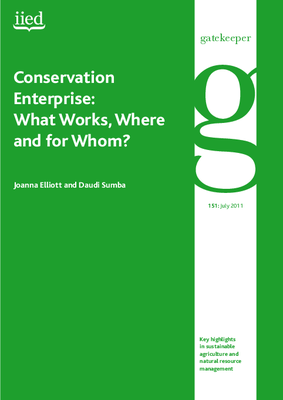Conservation Enterprise: What Works, Where and for Whom?

Author(s): Joanna Elliott and Daudi Sumba
Publication Date: 2011
Location: Africa: Botswana, Namibia. Latin America: Bolivia, Colombia, Nicaragua, Panama, Peru. Asia: Nepal.
DOWNLOAD FILE
Key points in document
- This paper reviews experiences from the field to examine how conservation enterprises can move communities out of poverty while conserving biodiversity.
- Multiple examples and case studies on conservation enterprises developed by multiple conservation-based organizations are provided.
- The document concludes with overarching themes for successful conservation enterprises and the main challenges that they face moving forward.
- Six characteristics that lead to projects that can successfully target community livelihoods and biodiversity conservation are: (1) a clear conservation logic to ensure that the enterprise is addressing biodiversity threats; (2) commercial success of a product, and the knowledge that a market and profit potential exists for that product; (3) proper development of private sector and (4) community-level partnerships will ensure longevity of the enterprise and create a useful support system; (5) community ownership of the enterprise and enforcement of benefits by community members is necessary (these factors are made possible through effective governance structures, strong resource rights, and attention to equal benefit distribution); and (6) benefit-sharing arrangements must be transparent to ensure equal benefit distribution.
- These six factors build upon external factors including market conditions and the supportive legal frameworks that govern the target community.
Information relevant to Learning Questions:
Are enabling conditions in place to support a sustainable enterprise?
- Ownership, governance
- Business alliances
- Financial management capacity, technical capacity
- Inputs
- Benefit sharing, targeted participants, combined strategic approaches, biodiversity linkage, planning for external disturbance
Does the enterprise lead to benefits to stakeholders?
- Increased income for participants
- Non-cash benefits
Do the benefits lead to positive changes in attitudes and behavior?
- Attitudes regarding sustainable use of resources
- Behaviors regarding sustainable use of resources
Does a change in stakeholders’ behaviors lead to a reduction to threats to biodiversity (or restoration)?
- Agriculture and aquaculture
- Biological resource use
Does a reduction in threats (or restoration) lead to conservation?
- Forest ecosystems
- Species


